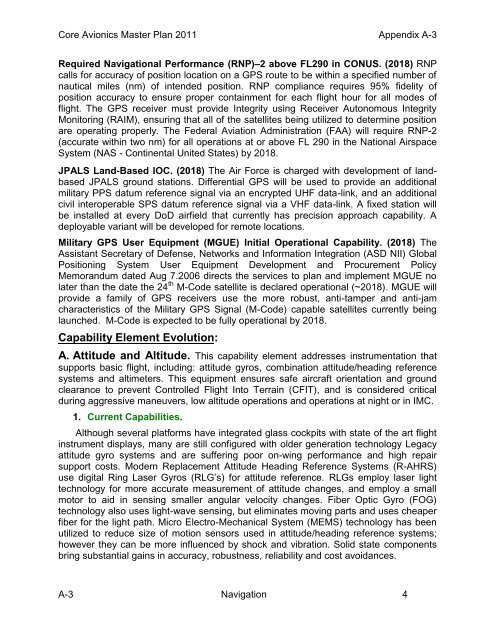Core Avionics Master Plan - NAVAIR - U.S. Navy
Core Avionics Master Plan - NAVAIR - U.S. Navy
Core Avionics Master Plan - NAVAIR - U.S. Navy
- No tags were found...
Create successful ePaper yourself
Turn your PDF publications into a flip-book with our unique Google optimized e-Paper software.
<strong>Core</strong> <strong>Avionics</strong> <strong>Master</strong> <strong>Plan</strong> 2011 Appendix A-3Required Navigational Performance (RNP)–2 above FL290 in CONUS. (2018) RNPcalls for accuracy of position location on a GPS route to be within a specified number ofnautical miles (nm) of intended position. RNP compliance requires 95% fidelity ofposition accuracy to ensure proper containment for each flight hour for all modes offlight. The GPS receiver must provide Integrity using Receiver Autonomous IntegrityMonitoring (RAIM), ensuring that all of the satellites being utilized to determine positionare operating properly. The Federal Aviation Administration (FAA) will require RNP-2(accurate within two nm) for all operations at or above FL 290 in the National AirspaceSystem (NAS - Continental United States) by 2018.JPALS Land-Based IOC. (2018) The Air Force is charged with development of landbasedJPALS ground stations. Differential GPS will be used to provide an additionalmilitary PPS datum reference signal via an encrypted UHF data-link, and an additionalcivil interoperable SPS datum reference signal via a VHF data-link. A fixed station willbe installed at every DoD airfield that currently has precision approach capability. Adeployable variant will be developed for remote locations.Military GPS User Equipment (MGUE) Initial Operational Capability. (2018) TheAssistant Secretary of Defense, Networks and Information Integration (ASD NII) GlobalPositioning System User Equipment Development and Procurement PolicyMemorandum dated Aug 7.2006 directs the services to plan and implement MGUE nolater than the date the 24 th M-Code satellite is declared operational (~2018). MGUE willprovide a family of GPS receivers use the more robust, anti-tamper and anti-jamcharacteristics of the Military GPS Signal (M-Code) capable satellites currently beinglaunched. M-Code is expected to be fully operational by 2018.Capability Element Evolution:A. Attitude and Altitude. This capability element addresses instrumentation thatsupports basic flight, including: attitude gyros, combination attitude/heading referencesystems and altimeters. This equipment ensures safe aircraft orientation and groundclearance to prevent Controlled Flight Into Terrain (CFIT), and is considered criticalduring aggressive maneuvers, low altitude operations and operations at night or in IMC.1. Current Capabilities.Although several platforms have integrated glass cockpits with state of the art flightinstrument displays, many are still configured with older generation technology Legacyattitude gyro systems and are suffering poor on-wing performance and high repairsupport costs. Modern Replacement Attitude Heading Reference Systems (R-AHRS)use digital Ring Laser Gyros (RLG‟s) for attitude reference. RLGs employ laser lighttechnology for more accurate measurement of attitude changes, and employ a smallmotor to aid in sensing smaller angular velocity changes. Fiber Optic Gyro (FOG)technology also uses light-wave sensing, but eliminates moving parts and uses cheaperfiber for the light path. Micro Electro-Mechanical System (MEMS) technology has beenutilized to reduce size of motion sensors used in attitude/heading reference systems;however they can be more influenced by shock and vibration. Solid state componentsbring substantial gains in accuracy, robustness, reliability and cost avoidances.A-3 Navigation 4
















